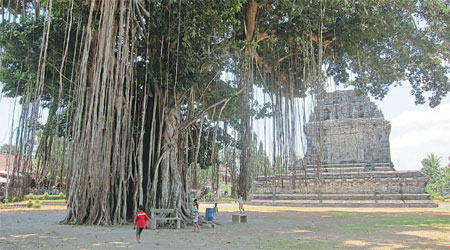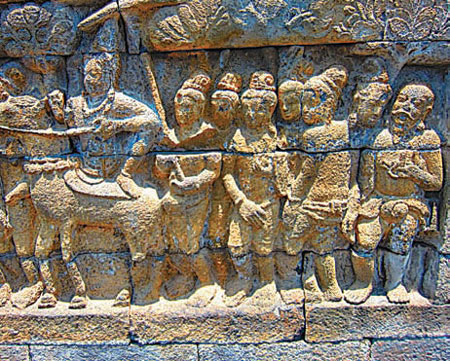
 |
|
Borobudur is essentially a colossal stone picture book that informs people how to behave. Both the faithful and nonbelievers will find the sojourn to Borobudur to be a spiritual journey. [Photos by Erik Nilsson / China Daily] |
 |
|
The bas-reliefs on the monument narrate Buddha's journey to enlightenment.[Photo/China Daily] |
Pilgrims to Indonesia's Borobudur Mahayana Buddhist temple in Java are in for an allegorical treat, reports Erik Nilsson, who takes the tour.
The story of Indonesia's Borobudur Mahayana Buddhist temple begins with a two-headed bird. The top head enjoyed the best fruit, while the bottom complained it only got the leftovers. "What does it matter?" the top head retorted. "It all goes to the same stomach." That turned out to be exactly the problem, when the lower head devoured toxic toadstools, killing the warbler.
|
 |
The tale of animalistic greed is the antithesis of the large perforated stupa that crowns the holy site and represents enlightenment's highest level. While the stupa is surrounded by 72 smaller topes inhabited by Buddha statues, the crown jewel is mysteriously empty.
Pilgrims startfrom the bird relief and walk clockwise twice around every tier. The first time, they are meant to study and reflect upon the bottom row of carvings - all fables told through animals.
The second time, they are supposed to examine the top row of legends about Buddha's journey to enlightenment. They continue on two more trips up six quadrangular tiers crowned by three circular levels.
Borobudur is essentially a colossal stone picture book that informs people how to behave.
Take the etched story of the turtle that took flight by clenching in his maw a piece of wood carried by two birds. When the other animals marveled at the birds' strength, the turtle declared it was his prowess they should be impressed with. But when he opened his mouth to boast, he released the wood and plummeted to his demise.
The moral is: Pride can be fatal.
So can be attaching yourself to the powerful, as was learned by the monkey, who tethered his body to a cowardly lion who fled a goat, dragging the primate to death.
|
 |
After Islam came to dominate the area, Borobudur hibernated, smothered beneath a coat of volcanic ash and vegetation. But its legacy persisted as legend.
During the 18th century, Javanese conception of Borobudur reversed from blessed to accursed.
Many believe Prince Monconagoro's 1757 death from illness resulted from a hex the temple cast on him during his visit a year earlier.
The step-pyramid was unsheathed in 1814, when Britain's administrator of Java, Sir Thomas Stamford Raffles heard of its existence from local folktales and sent a team to hack away the flora and scrape off the soil.
This excavation also cleared the way for looters, who plundered statues and reliefs, many of which now stock museums and private collections around the planet.
Raffles' interest in Borobudur was more personal than governmental. And he had little inkling he was uncovering what would become Indonesia's most visited attraction from the 1970s on and a UNESCO World Heritage site.
Since the 1980s, it has survived extremist bombings, an earthquake, vandalism and the soil erosion that still threatens its structural integrity.
That's not to mention Mount Merapi's 2010 eruption, which dumped 2.5 centimeters of ash on the monument and added to the acid rain with which man-made pollution has already scrubbed the carvings.
Many experts believe Borobudur's location between two volcanoes and two rivers was intentional. Some also contend the stupa was conceived as a lotus blooming in a since-evaporated paleolake.
Borobudur is the mother of three temples situated along a straight line in Yogyakarta.
Pilgrims should walk to Pawon, a relatively tiny and empty shrine in the countryside, 1.7 km from Borobudur, and then another 0.7 km to Mendut, a mid-sized temple inhabited by statues.
The less devout often make the journey among the temples by horse-drawn carriage, witnessing such rural activities as pottering and tobacco harvesting.
The stream of believers turns into a flood during the first full moon of May or June, when Indonesia's Buddhists celebrate Vesak - a commemoration of Siddhartha Gautama's life and enlightenment.
But any time of year, the faithful and nonbelievers will find the sojourn to Borobudur to be a spiritual journey - or at least a trek into the otherworldly.
Contact the writer at erik_nilsson@chinadaily.com.cn.
|
|
|
